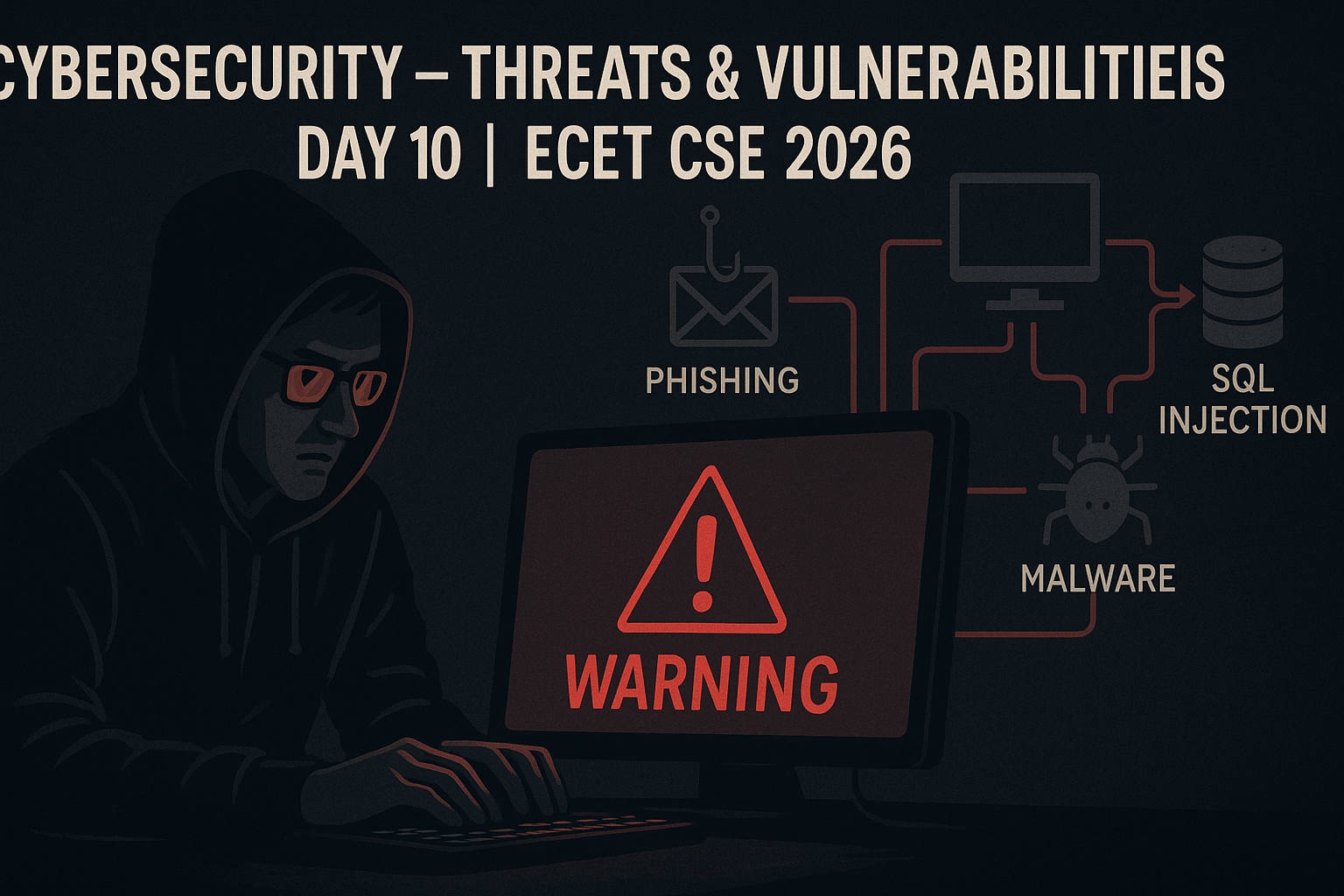
We’ll learn what cybersecurity threats exist, types of vulnerabilities in systems, and how to stay protected — with real-world examples + MCQs for exam practice.
Concept Notes: Cybersecurity – Threats & Vulnerabilities
🔹 1. What is Cybersecurity?
Cybersecurity is the protection of computer systems, networks, and data from digital attacks, damage, or unauthorized access.
🔹 2. What Are Threats?
A threat is any potential danger that can exploit a vulnerability to harm a system or data.
Examples:
- Virus or malware
- Phishing attacks
- Denial of Service (DoS)
- Ransomware
🔹 3. What Are Vulnerabilities?
A vulnerability is a weakness in a system that can be exploited by attackers.
Examples:
- Outdated software
- Weak passwords
- Unpatched security holes
- Open ports without firewall
🔹 4. Types of Cybersecurity Threats
| Threat | Description |
|---|---|
| Phishing | Fake emails/websites trick users to give passwords |
| Malware | Malicious software like viruses, worms, trojans |
| Ransomware | Locks your data and demands payment |
| SQL Injection | Attacker injects SQL code into input fields to access DB |
| Denial of Service | Flooding servers to make services unavailable |
🔹 5. Types of Vulnerabilities
| Vulnerability | Example |
|---|---|
| Software Bugs | Logic flaws in app |
| Human Error | Clicking on fake links |
| Misconfigured Servers | Leaving admin portals open |
| Weak Authentication | Reusing passwords, no 2FA |
🔹 6. Preventive Measures
- Use strong, unique passwords
- Enable Two-Factor Authentication (2FA)
- Update software regularly
- Install antivirus and firewall
- Educate users about phishing and social engineering
🧠 Top 10 MCQs – Cybersecurity Basics
1️⃣ What is the main goal of cybersecurity?
A) Speed up networks
B) Secure data and systems
C) Increase bandwidth
D) Improve UI
2️⃣ Which of the following is a type of malware?
A) Firewall
B) Trojan
C) HTTPS
D) SSH
3️⃣ What does phishing aim to do?
A) Improve performance
B) Trick users to reveal personal info
C) Fix bugs
D) Encrypt files
4️⃣ Ransomware is designed to:
A) Speed up PC
B) Encrypt and demand payment
C) Backup data
D) Optimize graphics
5️⃣ Which of these is a vulnerability?
A) Firewall
B) Unpatched software
C) HTTPS
D) Cloud storage
6️⃣ SQL Injection affects:
A) Web design
B) Firewalls
C) Databases
D) Hard drives
7️⃣ Strong password includes:
A) Only numbers
B) Only letters
C) Special characters + mix
D) Your birth date
8️⃣ 2FA means:
A) Two-Factor Authentication
B) Two-Firewall Access
C) File Authorization
D) Admin Filter App
9️⃣ What is the best prevention against phishing?
A) Software update
B) Don’t open unknown links
C) Change wallpaper
D) Enable JavaScript
🔟 Denial of Service attack targets:
A) Personal data
B) Server availability
C) Memory
D) Antivirus
✅ Answer Key
| Q.No | Answer |
|---|---|
| 1 | B |
| 2 | B |
| 3 | B |
| 4 | B |
| 5 | B |
| 6 | C |
| 7 | C |
| 8 | A |
| 9 | B |
| 10 | B |
📖 Explanations
- Q1: Cybersecurity protects systems and data.
- Q2: Trojans are malware disguised as normal apps.
- Q3: Phishing tricks you into giving info.
- Q4: Ransomware encrypts files and demands ransom.
- Q5: Unpatched software is a vulnerability.
- Q6: SQL injection manipulates databases.
- Q7: Strong passwords = mix of symbols, letters, numbers.
- Q8: 2FA adds an extra layer of login security.
- Q9: Best defense = awareness and link-checking.
- Q10: DoS attack floods servers to make them crash.
📥 Download Notes + MCQs PDF
📲 Join our Telegram: @learnnewthingsoffcial
Download Full PDF, Notes & Quiz Sets.
💬 Comment Challenge
💬 Comment one real-world cyberattack you know about or have read in the news!
![]()



